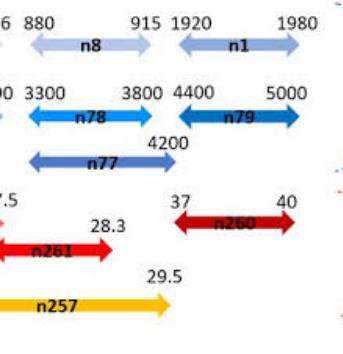What Frequencies Are Included in the 5G Spectrum?
Overview of the 5G Spectrum

The 5G spectrum encompasses a wide range of frequencies, designed to provide varying levels of network performance across different environments. These frequencies are segmented into two primary ranges: Frequency Range 1 (FR1) and Frequency Range 2 (FR2), each catering to different aspects of wireless communication needs.
Frequency Range 1 (FR1): Sub-6 GHz Bands
FR1, often referred to as the sub-6 GHz range, includes frequencies from 410 MHz up to 7.125 GHz. This range is crucial for providing broad coverage and penetrating buildings and other structures effectively. Here are some of the prominent bands within FR1:
- n1 (2100 MHz): Widely used for broad coverage in urban and suburban areas.
- n3 (1800 MHz): Favoured for its balance between coverage and capacity, suitable for a wide range of applications.
- n28 (700 MHz): Known for its excellent range and indoor penetration, ideal for rural coverage.
- n78 (3500 MHz): Provides higher data speeds with reasonable coverage, optimal for urban environments.
Frequency Range 2 (FR2): Millimeter Wave Bands
FR2 comprises the higher frequencies from 24.25 GHz to 52.6 GHz, utilizing millimeter wave (mmWave) technology. This range is key to achieving extremely high data rates necessary for applications requiring immense bandwidth. The specific bands include:
- n257 (26.5-29.5 GHz): Utilized for dense urban areas where high throughput is essential.
- n258 (24.25-27.5 GHz): Early adopted for its capacity to support rapid data transfer.
- n260 (37-40 GHz): Tailored for venues and areas with high user density, providing massive capacity.
- n261 (27.5-28.35 GHz): Similar to n257 and n258, but often used in slightly different regulatory environments.
Strategic Importance of 5G Frequencies
The 5G spectrum is not merely about faster internet speeds; it's about enabling a wide array of technologies and applications. The lower frequencies in FR1 are essential for ensuring widespread 5G adoption, providing the necessary coverage and penetration. In contrast, the higher frequencies in FR2 are critical for meeting the demands of high-data applications in dense urban settings, such as smart cities, autonomous driving, and immersive virtual reality experiences.
Navigating the 5G Landscape
Understanding the diverse frequencies that make up the 5G spectrum is key to appreciating the technology's potential and its impact on future connectivity. Each band within the 5G spectrum is chosen to balance the needs for coverage, capacity, and speed, setting the stage for a revolution in how we connect and interact with technology in our daily lives.